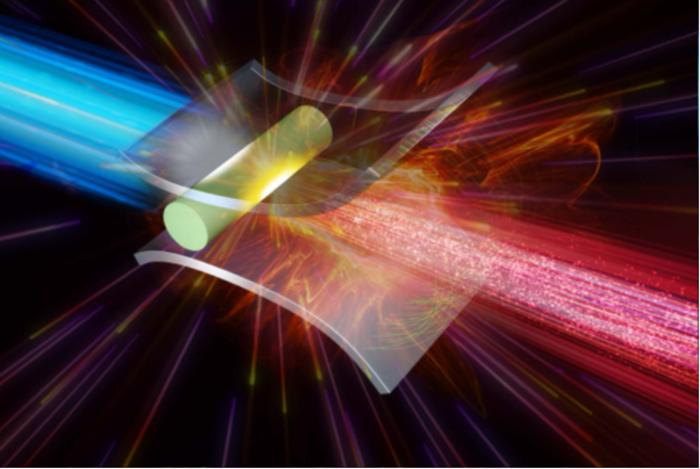In a groundbreaking development poised to reshape the landscape of particle acceleration, researchers at The University of Osaka have devised an innovative approach to generating proton beams with energies reaching the giga-electron-volt (GeV) scale. Historically, achieving such colossal energies necessitated sprawling and exorbitantly expensive particle accelerators, often spanning kilometers. However, this new method leverages microscopic engineering and state-of-the-art laser technology to produce high-energy protons within remarkably compact experimental setups, heralding a new era of accessible, high-performance particle acceleration.
At the core of this breakthrough lies a method termed micronozzle acceleration (MNA), conceptualized and led by Professor Masakatsu Murakami alongside his team. The technique introduces a meticulously structured microtarget, characterized by diminutive, nozzle-shaped cavities embedded within a solid hydrogen rod, which itself is encased in an aluminum construct. When subjected to ultrashort and ultraintense laser pulses, this microfabricated target facilitates the channeling and concentration of plasma flow, enabling the generation of a sustained quasi-static electric field inside the nozzle. This field acts as an effective accelerator environment, propelling protons to ultra-relativistic speeds in a stepwise fashion.
Traditional laser-driven proton acceleration has historically grappled with fundamental energy ceilings, primarily capped under 100 mega-electron-volts (MeV). Such constraints have limited applications in fields demanding higher particle energies. In contrast, the MNA approach harnesses the geometry of the micronozzle to circumvent these limitations. By confining and focusing the plasma sheath within the nozzle’s tight spatial boundaries, the electric field sustains a prolonged acceleration phase, thereby pushing proton energies beyond the 1 GeV threshold. This phenomenon marks a pivotal leap forward in laser-plasma interaction physics, backed by sophisticated computational modeling rather than conventional flat target configurations.
The computational simulations underpinning this achievement were executed with remarkable precision on the SQUID supercomputer at The University of Osaka. These multi-dimensional particle-in-cell simulations intricately modeled the interaction between ultraintense laser pulses and the microtarget, capturing nonlinear plasma dynamics, electromagnetic field evolution, and ion acceleration mechanisms with unprecedented fidelity. The results elucidated a fresh acceleration regime, distinguished by its stable and high-quality proton beams, which maintain tight energy spreads and minimized divergence—qualities essential for practical applications.
One of the most compelling aspects of the MNA mechanism is its scalability and the potential to license compact, cost-effective platforms for research and applied sciences. The generation of GeV-proton beams via such microstructured targets opens avenues beyond high-energy physics experiments. In the realm of fusion energy, specifically inertial confinement fusion, the ability to rapidly deliver high-energy proton beams could support fast ignition schemes, where precise and high-intensity energy deposition ignites the fusion fuel more efficiently, potentially surmounting longstanding technical barriers.
Moreover, the implications in medical physics are profound. Proton therapy has established itself as a gold standard for cancer treatment due to its ability to deposit maximal energy within tumors while sparing healthy tissue. Presently, proton accelerators are bulky and expensive, limiting global accessibility. The MNA approach heralds a future where compact, laser-driven proton sources can be integrated into hospital settings, significantly reducing the footprint and cost of proton therapy systems, while enhancing beam control and precision.
Beyond medicine and energy, MNA may catalyze progress in fundamental science. By generating proton beams with energies and qualities previously attainable only in massive installations, laboratory astrophysics experiments simulating cosmic phenomena become more feasible. For instance, recreating particle acceleration mechanisms in supernova shocks or exploring the behavior of matter under extreme electromagnetic fields can be directly investigated under controlled conditions, fueling insights into processes governing the universe’s most energetic environments.
The technique’s underpinning physics is rooted deeply in laser-plasma interaction theory and plasma electrodynamics. As the ultraintense laser pulse impinges on the hydrogen rod within the aluminum nozzle, rapid ionization ensues, creating a dense plasma. The geometric confinement inherent in the nozzle focuses plasma flow, thereby amplifying localized electric fields beyond those achievable with planar targets. The intense quasi-static electric fields persist over durations sufficient to accelerate protons incrementally, synchronizing with the particle motion in a way that mitigates energy dispersion, a significant limitation in prior acceleration methodologies.
This elegant synergy of microfabrication, laser physics, and computational simulation underscores a broader trend in particle acceleration research: miniaturization without compromise on beam quality or energy. The Osaka team’s work not only exemplifies this trend but sets a benchmark for leveraging advanced numerical tools to predict and optimize complex physical phenomena prior to experimental validation, demonstrating how theory-driven insights can fast-track technological innovations.
Future directions for this research include experimental realization of the micronozzle targets using cutting-edge micro- and nanofabrication techniques, as well as the deployment of next-generation high-powered laser facilities. Collaborative efforts will aim to validate simulation predictions, optimize target materials and geometry for maximum acceleration efficiency, and explore integration strategies for clinical and industrial applications. If successful, this could trigger a paradigm shift in how proton beams are produced and utilized across scientific and technological domains.
In contemplating the broader scientific ecosystem, MNA serves as a beacon illuminating the fertile intersection of laser science, materials engineering, and computational physics. The fusion of these disciplines not only advances our understanding of fundamental particle acceleration processes but also accelerates translational technologies with transformative societal benefits. From energy sustainability challenges to advanced cancer therapies and astrophysical explorations, the ripples from this development are poised to extend far beyond the laboratory.
———
Article Title: Generation of giga-electron-volt proton beams by micronozzle acceleration
News Publication Date: 31-May-2025
Web References: http://dx.doi.org/10.1038/s41598-025-03385-x
Image Credits: Masakatsu Murakami
Keywords
Physical sciences, Physics, Particle physics, Subatomic particles, Nucleons, Protons




